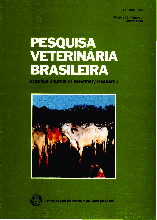 |
|
|
|
Year 2000 - Volume 20, Number 3
|

|
Complementary studies of the infection by Mannheimia granulomatis (lechiguana) in cattle, 20(3):91-96
|
ABSTRACT.- Pereira I.B., Riet-Correa F. & Ladeira S.S. 2000. [Complementary studies of the infection by Mannheimia granulomatis (lechiguana) in cattle.] Estudos complementares da infecção por Mannheimia granulomatis (lechiguana) em bovinos. Pesquisa Veterinária Brasileira 20(3):91-96. Laboratório Regional de Diagnóstico, Faculdade de Veterinária, Universidade Federal de Pelotas, 96010-900 Pelotas, RS, Brazil.
Several experiments were performed to demonstrate the role of Dermatobia hominis in the etiology of lechiguana: (1) One calfwas infected simultaneouslywith Dermatobia hominis larvae and Mannheimia granulomatis. Biopsies were performed in two larval lesions. An eosinophilic lymphangitis with connective tissue proliferation, similar to those observed in lechiguana, were present in one biopsy. (2) To detect if Dermatobia hominis is a carrier of Mannheimia granulomatis, a bacteriologic studywas performed in 72 larvae and the same number of exudate samples from larval lesions. The bacterium was not isolated. (3) In 9 cattle spontaneously infected by Dermatobia hominis, the larval lesions were inoculated with Mannheimia granulomatis. One bovine whose larval lesions were contaminated with bacteria developed a lechiguana 3 months after inoculation. (4) Two fibroproliferative lesions, clinically similar to lechiguana, caused by Dermatobia hominis larvae were studied. Histologically, these lesions were characterized by proliferation of fibrous tissue with focal granulomas. Eosinophilic lymphangitis and calcification of collagenous fibers were not observed in the lesions. As Dermatobia hominis occasionally produces a fibrogranulomatous reaction, it is possible that this can be the initial lesion for lechiguana, ifinfected by Mannheimia granulomatis. (5 and 6) Two experiments were performed to detect if healthy cattle can carry Mannheimia granulomatis. The bacterium was not isolated from the tonsils of 153 cattle, and the immunoditfusion test to detect antibodies in cattle was not sufficiently sensitive to detect carrier cattle. (7) Seventeen new spontaneous cases of lechiguana are reported. All cases had the same clinicai and pathologic characteristics as previously described. Fourteen cases were from southern Rio Grande do Sul, three were from the state of Santa Catarina and one from Paraná. |
| |
|
|
| |
|
 |